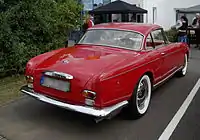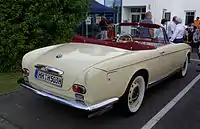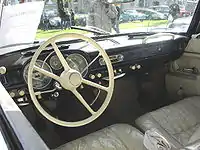BMW 503
The BMW 503 is a two-door 2+2 gran turismo manufactured by German automaker BMW from 1956 to 1959. The company developed the 503 alongside the 507 roadster in an attempt to sell a significant number of luxury cars in the United States. The 503 and 507 cost about twice their projected price and did not recover their costs. During production from May 1956 to March 1959, 413 units of the 503 were built. Even though it was a prestige model it resulted in heavy losses for BMW.
| BMW 503 | |
|---|---|
.jpg.webp) | |
| Overview | |
| Manufacturer | Bayerische Motoren Werke AG (BMW) |
| Production | May 1956 – March 1959[1] 413 built[1] |
| Designer | Albrecht von Goertz |
| Body and chassis | |
| Class | Grand tourer (S) |
| Body style | 2-door 2+2 seater coupe 2-door 2+2 seater cabriolet[2] |
| Layout | FR layout |
| Related | BMW 507 BMW 502 |
| Powertrain | |
| Engine | 3,168 cc (193 cu in) BMW OHV V8[3] |
| Transmission | 4-speed manual |
| Dimensions | |
| Wheelbase | 2,835 mm (111.6 in)[2][4] |
| Length | 4,750 mm (187 in)[4] |
| Width | 1,710 mm (67 in)[4] |
| Height | 1,440 mm (57 in)[4] |
| Curb weight | 1,500 kg (3,300 lb) approximately[4][5] |
| Chronology | |
| Predecessor | BMW 327 |
| Successor | BMW 3200 CS |
Concept and design
Hanns Grewenig, sales manager of BMW, repeatedly requested the development of a sports car based on their 501 and 502 luxury sedans.[6] In early 1954, influenced by the public reaction to Mercedes-Benz 190SL and 220 SC show cars in New York in February 1954, the management of BMW approved the project.[7]
Max Hoffman, an influential automobile importer in the United States, saw early design sketches by BMW's Ernst Loof, and suggested to industrial designer Albrecht von Goertz that he should submit design proposals to BMW.[8][9] Based on these proposals, BMW contracted Goertz to design the 503 and 507 in November 1954.[10]
The 503 was a 2+2 grand tourer that was available as either a coupe or a convertible. It was noted for having a cleaner and more modern design than the "Baroque Angel" 501-based sedans.[11] The convertible version of the 503 was the first European convertible with an electrically operated top.[12]
 BMW 503 coupe
BMW 503 coupe BMW 503 convertible
BMW 503 convertible Interior
Interior
Engineering and development
Tasked with designing rolling chassis for two cars while using as much as possible from the existing 502 sedan, engineer Fritz Fiedler designed two versions of a new ladder frame, one with the same wheelbase as the 502, and one with a shortened wheelbase. The long-wheelbase version was used in the 503.[2] Both cars used the steering system and a variant of the front suspension system from the 502; the 503 also used the 502's rear suspension.[3] As originally designed, the 503 used the 502's remote gearbox placement and shift linkage.[2] Both cars used the braking system developed for the 3.2 sedan, using drum brakes with vacuum assist.[3] All 503s were configured for left hand drive.[13]
Both cars used the 3.2 L version of the 502's V8 engine developed for the 3.2 sedan, but with two carburetors and with an improved lubrication system using a chain-driven oil pump. The 503's V8 had a compression ratio of 7.5:1 and yielded 140 bhp (104 kW; 142 PS) at 4800 rpm.[3][9]
The 503 had sixteen inch wheels and standard final drive ratio of 3.90:1,[2] A final drive ratio of 3.42:1 was optional.[3] Acceleration of the 503 from standstill to 100 km/h (62 mph) had been measured at 13 seconds; the top speed of the 503 is about 115 miles per hour (185 km/h).[5]
In September 1957, the 503's drivetrain was revised. The gearbox was bolted to the transmission and the shifter was moved from the steering column to the floor.[4][5][12][13]
Reception
Hoffman had wanted BMW's sports and GT cars to be positioned between Triumph's sports cars and the Mercedes-Benz 190 SL,[2] at a selling price close to US$5000.[1] He told BMW he would order thousands of their sports cars at a purchase price of DM12,000.[14] After its introduction at the Frankfurt Motor Show in September 1955, the 503 began production in May 1956 with a selling price of DM29,500, while the 507 roadster sold for DM26,500 when it began production seven months later.[1]
While a minority, such as Battista "Pinin" Farina's, felt the 503 was superior in design to the 507,[1][9] the 503 was largely overshadowed by it.[1][11][12] However, while neither the 503 nor the 507 sold well enough to earn a profit,[15][16] the larger, heavier, plainer, more expensive 503 sold 412 units to the 507 roadster's 253.[12][17] 139 of the 503s made were convertibles.[4] Production ended in March 1959.[1]
Legacy
The 503 was BMW's first postwar sports coupe.[18] It was replaced by the Bertone-bodied BMW 3200 CS in 1962.[19][20]
A 1956 BMW 503 Cabriolet with Portuguese plates was driven by the George C. Scott character in the 1971 movie The Last Run.
A 1957 BMW 503 Coupé appears in the BBC drama Father Brown, episode 2, series 4, The Brewer's Daughter, first broadcast January 2016. That car was right hand drive.
References
Citations
- Norbye, Jan P., BMW - Bavaria's Driving Machines, p.115
- Norbye, p.96
- Norbye, p.113
- Car Body Design: BMW 507 and 503 (1955-1960)
- Norbye, p.116
- Norbye, p. 95
- Norbye, pp. 95-96
- Norbye, pp. 113-114
- Buckley, Martin, BMW Cars, p. 40
- Norbye, pp. 114-115
- Noakes, Andrew, The Ultimate History of BMW, pp. 49-50
- Lewin, Tony, The Complete Book of BMW: Every Model since 1950, pp. 28-29
- Buckley, p. 41
- Noakes, p. 52
- Norbye, p. 130
- Lewin, pp. 29-31
- Norbye, p. 251
- Langworth, Richard M., Complete Book of Collectible Cars: 70 Years of Blue Chip Auto Investments 1930-2000, p. 49
- Noakes, pp. 63, 65
- Norbye, pp. 131-132
Sources
| Wikimedia Commons has media related to BMW 503. |
- Books and journals
- Buckley, Martin (2001) [2001]. BMW Cars. St. Paul, MN USA: MotorBooks International. Coupe Elegance–The Forgotten 503, pp. 40-41. ISBN 0-7603-0921-3. Retrieved 2013-12-09.
- Langworth, Richard M. (2000). Complete Book of Collectible Cars: 70 Years of Blue Chip Auto Investments 1930-2000. Publications International. p. 49. ISBN 0-7853-4313-X. Retrieved 2013-12-09.
- Lewin, Tony (2004). "Faded glory". The Complete Book of BMW: Every Model since 1962. St. Paul, MN USA: Motorbooks International. pp. 23–37. ISBN 0-7603-1951-0. Retrieved 2013-12-08.
- Noakes, Andrew (2005). The Ultimate History of BMW. Bath, UK: Parragon Publishing. ISBN 1-4054-5316-8.
- Norbye, Jan P. (1984). "Postwar Panache: Baroque Angels, Timeless Sports Cars". BMW - Bavaria's Driving Machines. Skokie, IL, USA: Publications International. ISBN 0-517-42464-9. LCCN 84060309.
- Web sites
- Albrecht von Goertz (21 November 2006). "BMW 507 and 503 (1955-1960)". Car Body Design. Rome, Italy: FTM Studio. Retrieved 23 June 2010.